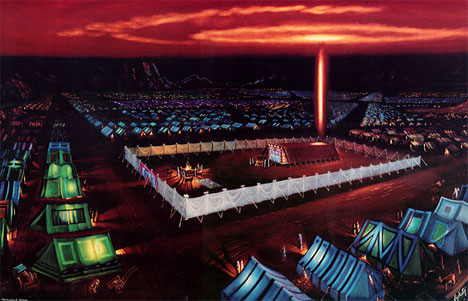The Household of Faith – 2
Part II – The Black Sabbath
“For the cloud of the Lord was on the tabernacle by day, and fire was in it by night,
in the sight of all the house of Israel throughout all their journeys.” (Exodus 40:8)
Continued from The Household of Faith – 1
“You shall kindle no fire in all your dwelling places on the Sabbath day.” (Exodus 35:3)
Israel took the man who was collecting kindling on the Sabbath and nipped his sin in the bud. His intentions were plain, so they wanted to know what should be done with him. It sounds brutal, but Exodus and Leviticus give us a plethora of strange laws for Israelites. At least, they seem strange until we understand that not only was Sinai replicated in the Tabernacle, the Tabernacle was to be replicated in every Israelite tent, and indeed in every Israelite. Every household was a tent of God, a cloud, and every Israelite a burning star in the sky. The tribes were, after all, arranged around the tent in military “constellations.” This new Black Sabbath was to reconnect every tent with its source, the tent of God.
The man executed for collecting kindling is referred to not as an Adam but as an Ish. Ish is Adam’s “new name,” a Covenant/bridal name, in Genesis 2. It may be related to the word for fire. “Strange fire” is thus spiritual harlotry, and this man is a Covenant breaker. He has put his own household, his own authority, above the authority of God. Perhaps the reason his actual motives are not recorded is the same reason such things are not recorded elsewhere in the Bible. It is to force us to contemplate the events in the fiery light of the Law. We are called to judge these situations, just as Israel did in this instance. This is one time they got it right. [1]
What was the reason for the introduction of the Mosaic Law? It was because of transgressions, not merely those of this generation, but also of the tribal heads, the lawless brothers of Joseph. The multiplication of Israel into a nation required a national law, although, as suggested above, this law also made every Israelite a “living sacrifice.” Its ethical, ceremonial and civil elements cannot be untangled from each other, any more than Father, Son and Spirit could be divided.
On the Sabbath day, the only fire was to be God’s fire. The only warmth, God’s warmth. The only light, God’s light. To have one other light visible among the tents would be to claim autonomy. Perhaps this darkness was a disciplinary measure after the idolatry of the golden calf. Without a fire for every household, the Sabbath would have resembled the ninth plague in Egypt, where the entire land but for Goshen was veiled in darkness. And Goshen was a Garden. A single brightness coming from the tent of meeting would be like the flaming sword at the Gate of God. Every Sabbath would be a reminder that Israel had failed to enter into God’s rest.
Immediately after this new commandment, Moses called for donations for the construction of the Tabernacle. This was a new creation. Light and darkness had been divided, with only the light of God visible. That was Day 1. Now the construction of a new house began.
At the end of this process, the glory of God moved in, and those who had been in darkness saw a great light. This building process takes us from Day 1 to Day 7, and we see a correspondence in Israel’s entire festal year, with one major difference.
The Sabbath Week becomes the “first day” in a sense, as a pattern for the entire year. And the Feast of Booths becomes Day 7, when Israel, after the Day of Atonement, has been purified, and is now ready to invite all nations to participate. It is at this feast that every house becomes a “glory cloud.” At the Feast of Booths (Ingathering), every house had its own fire. In this great international feast, Israel symbolically entered into God’s rest. Instead of a Black Sabbath like that of Adam, God became the father of lights. His promises would still come to pass.
____________________________________
[1] For a manifold revelation of how often we moderns misjudge the events of Genesis, get a copy of James B. Jordan’s Primeval Saints.



























November 11th, 2013 at 12:06 pm
Cool.